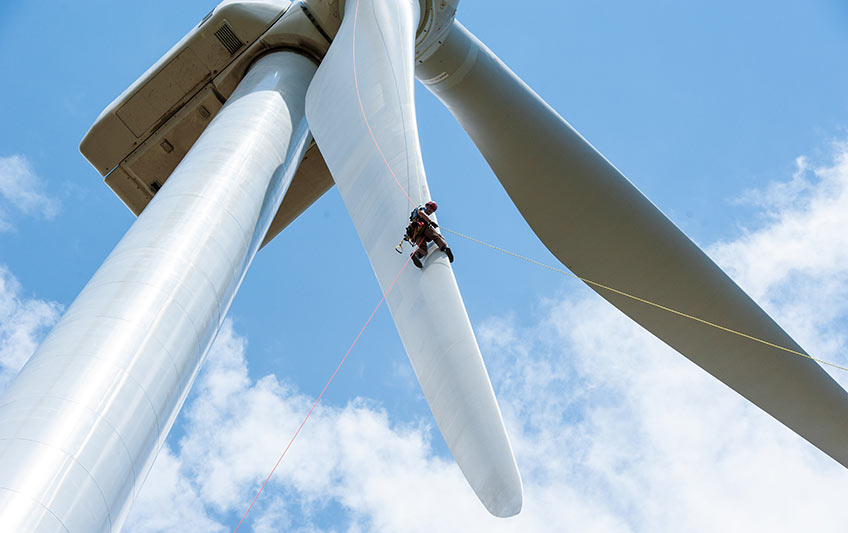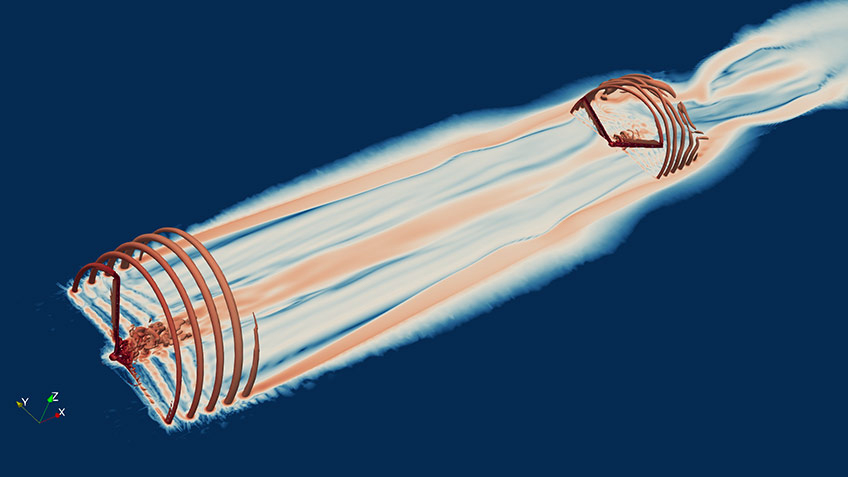The Leading Edge: December 2019 Wind Energy Newsletter
In this edition of the Leading Edge, we reflect on the science and engineering accomplishments from NREL's wind program in 2019 and look at the future of land-based and offshore-wind energy research.
News Stories
NREL's Top Wind Accomplishments of 2019
From wind turbines with social skills to the fast-growing and long-lasting demand for skilled wind industry workers, 2019 saw gale-force developments in wind energy research at NREL, and forecasts show no signs of slowing.
Pushing the Boundaries of Land-Based Rotor Growth
Researchers from NREL and Sandia National Laboratories are searching for ways to maximize the advantages of large-scale rotors and their potential for increased energy generation. The greater swept area created by giant blades helps wind power plants capture more wind energy and higher wind speeds at elevated heights. But the length and weight of these blades can create transportation, manufacturing, and logistical challenges that prevent scaling turbines up to sizes that make true on the adage bigger is better.

Hanging on the leading edge. Science and engineering advances in rotor growth can increase capacity factors, or the amount of power a turbine outputs on average over the course of a year. Photo by Dennis Schroeder, NREL
NREL To Develop Revolutionary Floating Offshore Toolset
NREL and its team of partners and external advisers seek to incorporate controls co-design principles—designing and optimizing all system components, including the control system, simultaneously—in a revolutionary toolset to enable offshore floating system engineers to design radically new systems at greatly reduced cost. The new open-source, user-friendly toolset will be developed under the U.S. Department of Energy's Advanced Research Projects Agency-Energy's Aerodynamic Turbines Lighter and Afloat with Nautical Technologies and Integrated Servo-Control program.
NREL Researchers Pursue the Biggest Possible Wind Plant Model
The physics impacting a wind power plant's performance are complex, and detailed models for entire wind plants remain out of reach for even today's fastest supercomputers. In fact, the need for a deeper understanding of atmospheric flow physics is one of three major challenges facing the wind industry today. That's why Paul Veers, the chief engineer at the National Wind Technology Center at NREL, collaborated with technical experts from around the world to develop an end-to-end resource covering every aspect of wind energy design, modeling, and simulation. The resulting two-volume book, which includes NREL contributions to 10 of the 18 chapters, addresses not only the difficulty of creating predictive models for wind plant performance but also the many disciplines required to solve it.

Making wakes. This graphic is a visualization of the tip-vortex structure and turbine wake interaction flow field from blade-resolved simulations of two NREL 5-megawatt wind turbines operating in uniform inflow using Nalu-Wind simulation code. Graphic by Shreyas Ananthan and Ganesh Vijayakumar, NREL
On the Radar
Shining (UV) Light on Inspired Innovation
For nearly 2 years, Flatirons Campus researchers have supported a research project that explores whether illuminating turbines with dim ultraviolet (UV) light will minimize bat impacts at wind energy plants. But Scott Schreck, a systems design engineer from Siemens Gamesa Renewable Energy (SGRE), saw another potential application for the custom-designed UV lights: illuminating the fluorescent tufts used in wind tunnel testing to indicate the direction of air flow.
The semiconductor lights used for wind-wildlife impact minimization at Flatirons provide high UV illumination at low cost and little difficulty. As there was no off-the-shelf UV light that fit the specifications required for Schreck’s development work at SGRE, he reached out to NREL to see if he could use a custom-designed "bat light" for a wind tunnel test to better illuminate air flow tufts. NREL contacted Dave Dalton from Bat Research and Consulting, who built the custom-designed bat lights and shipped SGRE an available unit.
The bat light presented several advantages for Schreck’s wind tunnel application. The compact size of the light and ease of connection made it relatively straightforward to modify the wind tunnel test section and then mount and connect the unit. The unit provided strong, even UV illumination across the tufts installed in the wind tunnel, which clearly visualized the flow field and enabled faster and more reliable interpretation of results as well as more efficient use of expensive wind tunnel testing time.
Learn more about other research projects and from NREL's Technology Development and Innovation Research program.
Downwind—In Case You Missed It
NREL's Wind Energy Program End-of-Year Accomplishments Showcased in 2019 Accomplishments Report
NREL's wind energy program conducts a broad portfolio of research and development projects that support the U.S. Department of Energy Wind Energy Technologies Office's mission to reduce costs and accelerate wind technology deployment. The 2019 Accomplishments and Year-End Performance Report showcases NREL achievements and innovations that help drive the industry forward.
U.S. Startup Secures Funding for Concrete Offshore Wind Foundation
NREL's 15-megawatt reference turbine will be used for a 2-year project to develop a modular concrete offshore wind turbine foundation. Through a grant from the U.S. National Offshore Wind Research and Development Consortium, startup company RCAM Technologies will design and assess the feasibility of the innovative structure. Read the article "U.S. Startup Secures Funding for Concrete Offshore Wind Foundation," at offhsorewind.biz.
NREL Model Predicts Lower Costs for Oregon Floating Offshore Wind
NREL's "Oregon Offshore Wind Site Feasibility and Cost Study" indicates the cost of deploying floating offshore wind could be 30% to 40% less than previously estimated. The study, funded by the Bureau of Ocean Energy Management, modeled the potential costs of floating offshore wind farms at least 10 nautical miles from Oregon's coast where wind speeds are some of the world's strongest. Portland Business Journal recently featured this research in the article, "Study Makes Case for Oregon Offshore Wind Power."
Publications
The Unsteady Aerodynamics Module for FAST8
Wind turbine rotors frequently experience unsteady aerodynamic loading as a result of turbulence, wind shear, control inputs, and off-axis operations. An NREL report covers the main theory and organization of the modularization framework of the new unsteady aerodynamics submodule, which includes unsteady aerodynamics under attached flow conditions and dynamic stall. The modularization framework explained in the report improves the utility and overall modularity of the FAST modularization framework.
The Verification and Validation Strategy within the Second Wind Forecast Improvement Project
The Second Wind Forecast Improvement Project focuses on Columbia River Gorge weather phenomena that pose unique challenges for wind and wind power forecasting. The project aims to understand and improve the skill accuracy of weather forecast models and includes an extensive field campaign in the Columbia River Gorge, located in the Pacific Northwest, during which data from many different instruments were collected. This report summarizes the verification and validation team's accomplishments during the project's 4-year duration and presents lessons learned toward an integrated verification and validation process across the U.S. Department of Energy's Atmosphere to Electrons initiative.
Share

